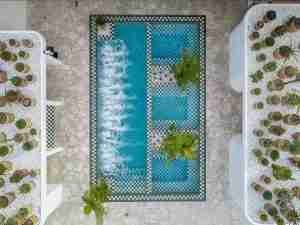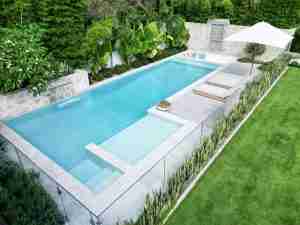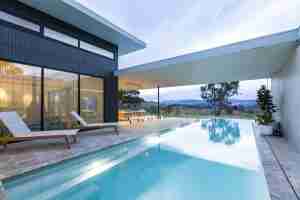When it comes to building a swimming pool, one of the key decisions you’ll have to make is choosing the right material. Concrete and fibreglass are two popular options that offer their own advantages and drawbacks. In this article, we will compare concrete and fibreglass pools to help you make an informed decision for your Australian backyard.
Understanding the Basics of Pool Materials
Before diving into the specifics, let’s start by understanding what exactly a concrete pool and a fibreglass pool are.
When it comes to choosing the right pool for your backyard oasis, it’s essential to consider the materials used in its construction. Two popular options are concrete pools and fibreglass pools. Each has its own unique characteristics and advantages, so let’s take a closer look at what sets them apart.
What is a Concrete Pool?
A concrete pool is constructed using a framework of steel-reinforced bars and a mixture of cement, sand, and water, commonly known as shotcrete or gunite. This mixture is sprayed onto the framework to create a solid and durable structure.
Concrete pools offer a high level of customization, as they can be built in any shape or size to fit your specific needs and preferences. They also provide excellent durability and longevity, with the potential to last for several decades with proper maintenance.
One of the key advantages of a concrete pool is its versatility. You can choose from a variety of finishes, such as tiles, pebbles, or plaster, to create a unique and visually appealing look. Additionally, concrete pools can be equipped with various features, including waterfalls, spas, and custom lighting, to enhance your swimming experience.
However, it’s important to note that constructing a concrete pool is a complex and time-consuming process. It typically requires excavation, formwork, and the expertise of skilled professionals. The construction timeline can vary depending on the size and complexity of the project, but it’s not uncommon for it to take several weeks or even months to complete.
What is a Fibreglass Pool?
In contrast, a fibreglass pool is pre-manufactured in a factory and delivered to your property as a single piece. Made from fibreglass-reinforced plastic, these pools are created by layering resin and fibreglass strands onto a mould, resulting in a smooth and seamless finish.
Fibreglass pools offer a quicker installation process compared to concrete pools. Since they arrive at your property as a complete unit, the installation time is significantly reduced. In many cases, a fibreglass pool can be installed and ready for use within a matter of days.
Another advantage of fibreglass pools is their low maintenance requirements. The smooth surface of the fibreglass shell makes it resistant to algae growth, reducing the need for frequent cleaning and chemical treatments. Additionally, the non-porous nature of fibreglass prevents water absorption, which helps to minimize the risk of cracks and leaks.
When it comes to design options, fibreglass pools may have some limitations compared to concrete pools. They are typically available in a range of standard shapes and sizes, which may not offer the same level of customization as concrete pools. However, many manufacturers now offer a variety of design enhancements, such as built-in steps, benches, and swim-out areas, to provide additional functionality and aesthetic appeal.
It’s worth noting that fibreglass pools may not be suitable for all locations. Due to their size and transportation requirements, access to your property must be carefully considered. Additionally, the ground conditions and any potential obstacles, such as trees or underground utilities, need to be assessed to ensure a successful installation.
Ultimately, the choice between a concrete pool and a fibreglass pool depends on your specific needs, budget, and preferences. Both options offer their own set of advantages and considerations, so it’s essential to carefully evaluate each before making a decision. Consulting with a pool professional can provide valuable insights and guidance to help you make an informed choice that will bring years of enjoyment and relaxation.
Factors to Consider When Choosing a Pool
Now that we have a basic understanding of the two pool materials, let’s explore the factors you should consider when making your decision.
Durability and Longevity
Both concrete and fibreglass pools are known for their durability, but they have different lifespans. A well-maintained concrete pool can last for decades, while a fibreglass pool generally has a lifespan of around 20 years. However, it’s worth noting that the finish of a concrete pool may require periodic resurfacing over time.
Installation and Construction Time
When it comes to installation, concrete pools typically take longer to build compared to fibreglass pools. The construction process involves excavation, reinforcing, and applying the shotcrete, which can take several weeks or even months. In contrast, fibreglass pools can be installed relatively quickly, often within a few days.
Maintenance and Upkeep
Maintenance requirements also differ between the two types of pools. Concrete pools are more porous, which can make them prone to algae growth and require more frequent brushing and chemical treatments. On the other hand, fibreglass pools have a non-porous surface that resists algae and requires less maintenance. However, they may be more susceptible to staining and can be damaged by abrasive cleaning methods.
Pros and Cons of Concrete Pools
Now let’s dive deeper into the specific advantages and disadvantages of concrete pools.
Aesthetic Appeal of Concrete Pools
One of the biggest advantages of concrete pools is their versatility in design. Since they are built on-site, they can be customized to any shape, size, or depth. This flexibility allows for creative and unique pool designs that can complement any landscaping style. Concrete pools also offer a variety of finish options, including plaster, tile, and aggregate, giving you even more control over the final look.
Flexibility in Design and Size
Concrete pools are not limited by mould or size restrictions, making them an excellent choice for those with specific design preferences or challenging backyard layouts. This flexibility also means that you can add features like attached spas, waterfalls, and custom steps to enhance your pool experience.
Cost Implications of Concrete Pools
However, it’s important to consider the cost implications of concrete pools. They tend to be more expensive upfront due to the materials and labour involved in the construction process. Additionally, the long-term maintenance costs can be higher due to the need for resurfacing and potential repairs down the line.
Pros and Cons of Fibreglass Pools
Now, let’s discuss the advantages and disadvantages of fibreglass pools.
Ease of Installation for Fibreglass Pools
Fibreglass pools offer a straightforward installation process since they arrive at your property as a complete unit. The pool is simply placed into the excavated hole, and any necessary plumbing and electrical connections are made. This streamlined installation can save both time and labour costs.
Energy Efficiency and Insulation
Fibreglass pools are known for their excellent insulation properties. The smooth surface and thick fibreglass shell help retain heat, reducing the energy required to maintain a comfortable water temperature. This can result in significant energy savings over time.
Cost Implications of Fibreglass Pools
While fibreglass pools offer initial cost savings and lower maintenance requirements, it’s essential to consider the limitations in terms of design and size. Since they are manufactured off-site, fibreglass pools come in a range of pre-determined sizes and shapes. This restricts the level of customization available, making them less suitable for those looking for unique or intricate pool designs.
In conclusion, when choosing between a concrete pool and a fibreglass pool, consider your priorities in terms of longevity, installation time, maintenance, design flexibility, and budget. Each option has its own unique advantages and disadvantages, and the best choice for you will depend on your specific needs and preferences. With proper care and maintenance, both types of pools can provide years of enjoyment and relaxation in your Australian backyard.




